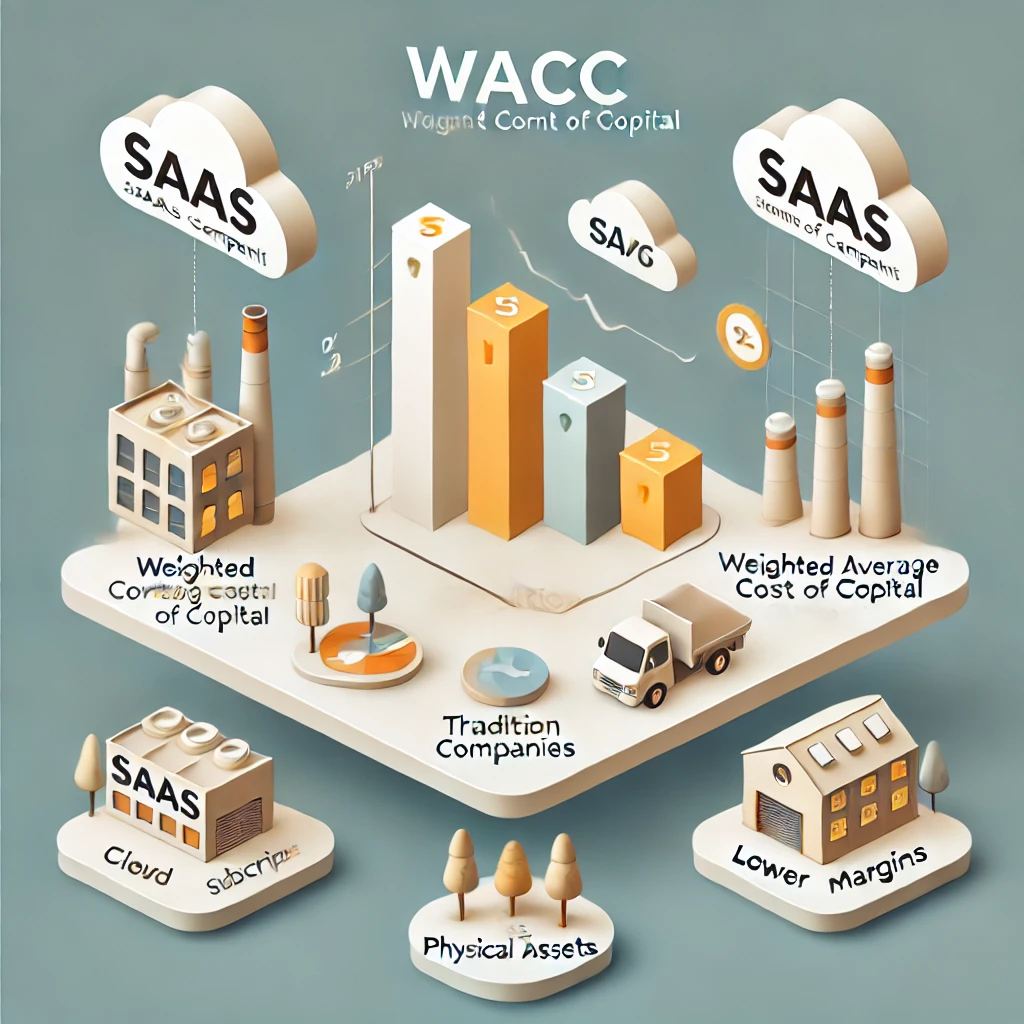
Do SaaS Companies Have a Lower WACC
Table of Contents
- Introduction to WACC and SaaS Companies
- Understanding WACC: A Quick Recap
- Key Factors Influencing WACC
- Why SaaS Companies May Have a Lower WACC
- Challenges SaaS Companies Face in WACC Optimization
- Comparison: SaaS vs. Traditional Companies WACC
- Best Practices for SaaS Companies to Optimize WACC
- Conclusion
Introduction to WACC and SaaS Companies
Weighted Average Cost of Capital (WACC) is a critical metric for businesses, reflecting the average rate of return a company must earn to satisfy its investors and creditors. For Software as a Service (SaaS) companies, the dynamics of WACC can differ significantly from traditional businesses due to their unique business models. So, do SaaS companies have a lower WACC? Let’s dive into the factors, challenges, and strategies that influence their cost of capital.
Affiliate Disclosure
This article may contain affiliate links, which means we may earn a commission if you make a purchase or sign up for a service through one of our links. This comes at no additional cost to you and helps support the maintenance and creation of valuable content on this website.
We only recommend products and services that we genuinely believe will bring value to our readers. Our opinions and recommendations are unbiased and based on thorough research and expertise. Thank you for supporting us!
Understanding WACC: A Quick Recap
WACC represents the weighted average of a company's cost of equity and cost of debt. It provides a benchmark for evaluating investment decisions, as businesses aim to generate returns higher than their WACC.
WACC Formula:
Where:
- E = Market value of equity
- D = Market value of debt
- V = Total value (E + D)
- Re = Cost of equity
- Rd = Cost of debt
WACC reflects how much a company pays on average to finance its operations. A lower WACC means cheaper capital, improving profitability and investment viability.
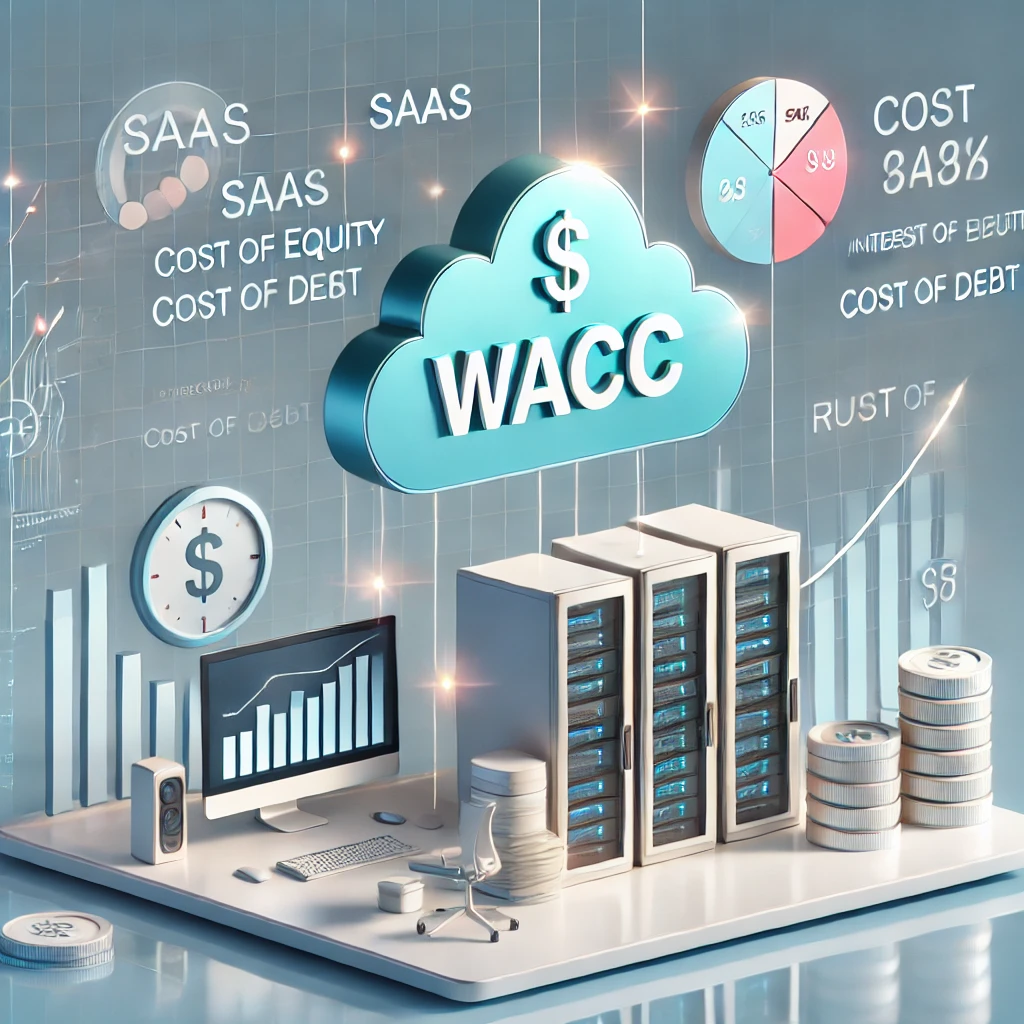
Key Factors Influencing WACC
Several elements determine WACC. Understanding these factors is essential for assessing whether SaaS companies typically enjoy a lower WACC.
Cost of Equity
The cost of equity represents the return investors demand for the risk of holding a company’s stock. It’s influenced by:
- Market Volatility: Higher stock volatility can increase cost of equity.
- Growth Prospects: High-growth sectors like SaaS may face higher expectations from investors.
Cost of Debt
The cost of debt is the effective rate a company pays on its borrowings. Factors include:
- Interest Rates: Lower interest rates reduce the cost of debt.
- Creditworthiness: High credit ratings decrease borrowing costs.
Capital Structure
The proportion of equity and debt financing affects WACC. SaaS companies often rely heavily on equity due to their growth-oriented nature.
Why SaaS Companies May Have a Lower WACC
SaaS companies operate with distinct characteristics that can influence their WACC, often leading to a lower cost of capital compared to traditional businesses.
Predictable Revenue Streams
- Subscription Model: The recurring revenue from subscriptions enhances cash flow predictability.
- Customer Retention: High retention rates reduce revenue volatility, lowering perceived risk.
High Gross Margins
- Scalability: SaaS platforms can scale rapidly without proportionate increases in costs, leading to gross margins often exceeding 70%.
- Operational Efficiency: High margins provide a cushion against financial risks, reducing the cost of equity.
Low Capital Expenditures
- Asset-Light Model: SaaS businesses do not require significant investments in physical assets, unlike traditional industries.
- Focus on R&D: Investment in intellectual property often yields higher returns, improving investor confidence.
Market Perception
- Growth Potential: The tech-driven nature of SaaS companies often positions them as high-growth opportunities.
- Resilience: Cloud-based models demonstrated resilience during economic downturns, enhancing their attractiveness to investors.
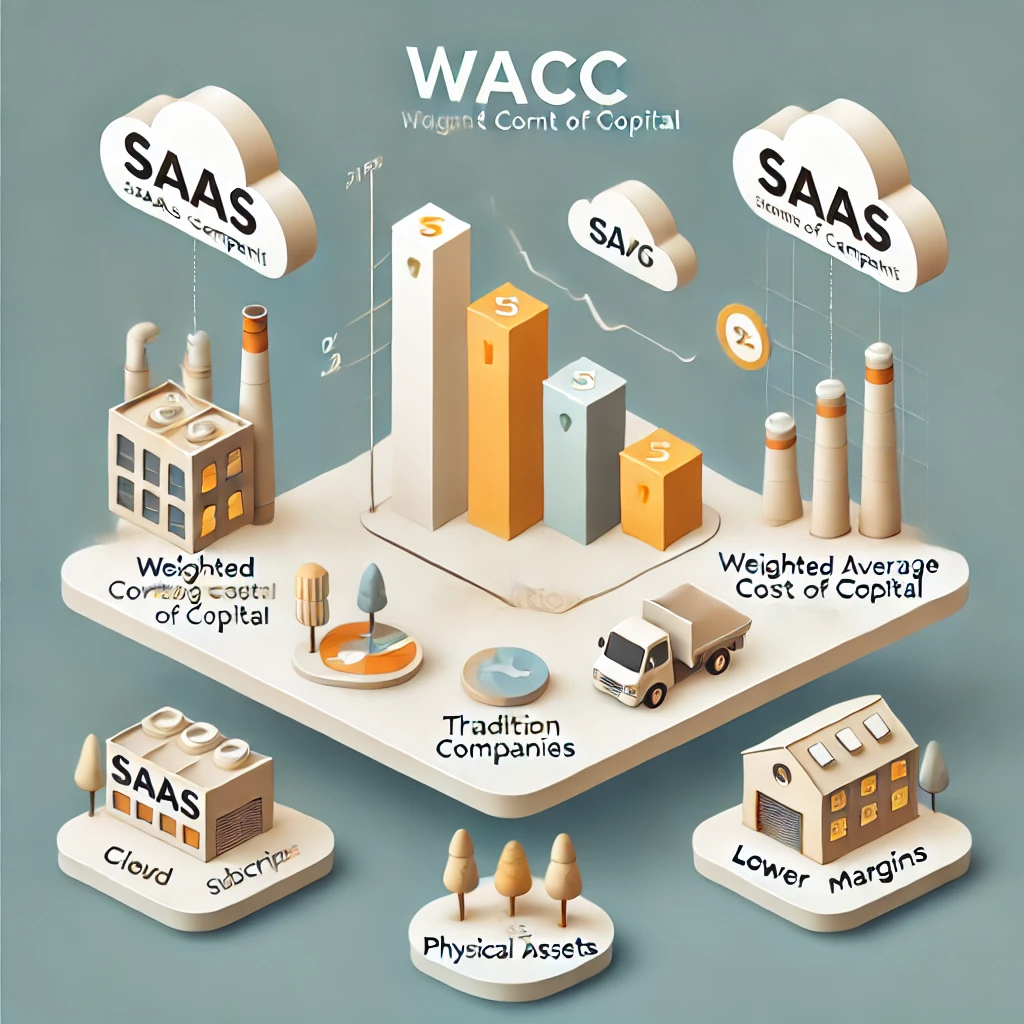
Challenges SaaS Companies Face in WACC Optimization
While SaaS companies have many advantages, they also encounter challenges that can influence their WACC.
- High Valuation Multiples: Elevated valuations can increase investor expectations, raising the cost of equity.
- Limited Debt Financing: Heavy reliance on equity financing can dilute ownership and increase the overall cost of capital.
- Competitive Markets: Intense competition in the SaaS space can lead to increased customer acquisition costs, impacting profitability.
- Economic Sensitivity: Macroeconomic conditions, such as rising interest rates, can influence SaaS valuations and debt costs.
Comparison: SaaS vs. Traditional Companies WACC
The differences between SaaS and traditional companies become evident when comparing their WACC components.
| Factor | SaaS Companies | Traditional Companies |
|---|---|---|
| Revenue Predictability | High (Subscription-Based) | Moderate/Low |
| Capital Intensity | Low | High |
| Gross Margins | 70%+ | Typically 20-40% |
| Cost of Equity | Moderate | Higher (Due to volatility) |
| Cost of Debt | Lower (High creditworthiness) | Higher (Asset-intensive) |
Best Practices for SaaS Companies to Optimize WACC
For SaaS companies, reducing WACC involves optimizing both cost of equity and cost of debt. Here are actionable strategies:
1. Strengthen Financial Stability
- Build robust cash reserves to demonstrate stability.
- Maintain predictable and growing revenue streams.
2. Diversify Funding Sources
- Leverage debt financing strategically to reduce dependency on equity.
- Explore venture debt or hybrid instruments for growth funding.
3. Enhance Operational Efficiency
- Invest in automation to reduce costs.
- Focus on customer success to improve retention and lifetime value.
4. Improve Investor Confidence
- Communicate clear growth strategies.
- Demonstrate resilience through data-driven insights.
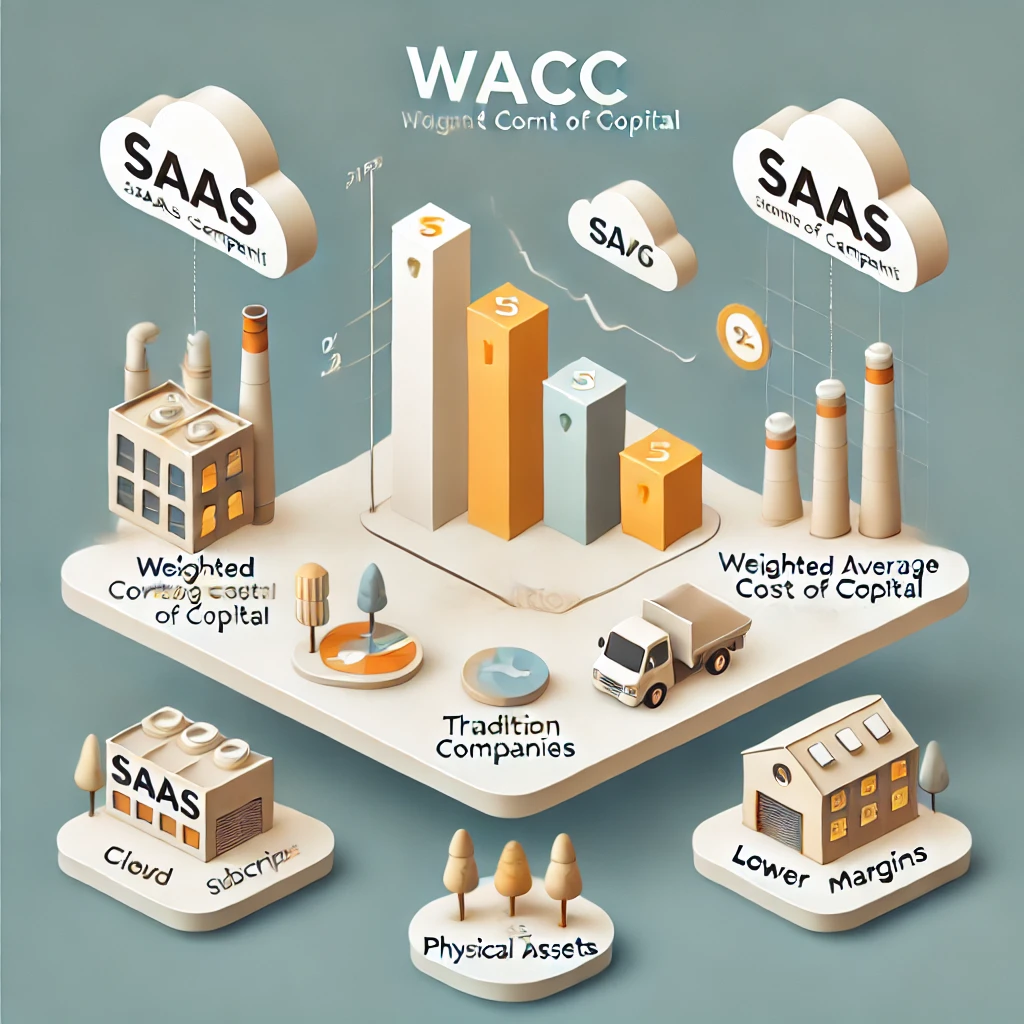
5. Monitor Economic Trends
- Stay updated on macroeconomic conditions.
- Hedge against interest rate fluctuations if applicable.
Affiliate Disclosure
This article may contain affiliate links, which means we may earn a commission if you make a purchase or sign up for a service through one of our links. This comes at no additional cost to you and helps support the maintenance and creation of valuable content on this website.
We only recommend products and services that we genuinely believe will bring value to our readers. Our opinions and recommendations are unbiased and based on thorough research and expertise. Thank you for supporting us!
Do SaaS Companies Have a Lower WACC?
Do SaaS companies have a lower WACC? The answer lies in their unique business models, characterized by predictable revenues, high gross margins, and low capital expenditures. While SaaS companies often enjoy a lower WACC compared to traditional businesses, optimizing it further requires strategic financial management and market adaptability.
By understanding the nuances of WACC and leveraging their operational advantages, SaaS companies can secure their position as capital-efficient leaders in the modern economy.
1. Historical Trends in WACC for SaaS Companies
- Why Include: Historical data contextualizes how WACC for SaaS companies has changed over time and helps predict future trends.
- Details: Explore data from the last 10–15 years, highlighting periods of economic growth, crises (like the 2008 recession or COVID-19), and their influence on SaaS valuations and financing costs.
- Example: Compare pre-pandemic SaaS WACC (2015–2019) versus during/post-pandemic (2020–2023), emphasizing market conditions and investor sentiment.
2. Impact of Macroeconomic Factors on SaaS WACC
- Why Include: Economic conditions like inflation and interest rate hikes directly influence the cost of debt and equity.
- Details: Analyze how SaaS companies fared during rising interest rate environments and inflationary periods. Address how changes in Federal Reserve policies impact SaaS WACC globally.
- Subtopics:
- The role of currency fluctuations for global SaaS players.
- Regional disparities in SaaS WACC due to differing macroeconomic policies.
3. The Role of Venture Capital in SaaS Financing
- Why Include: Venture capital is a significant funding source for SaaS startups and influences WACC through equity valuations.
- Details: Examine how venture-backed SaaS companies balance higher equity costs due to dilution against the benefits of lower upfront debt costs. Discuss how late-stage funding rounds impact investor expectations and capital structure.
- Case Study: Investigate a SaaS unicorn’s path through multiple funding rounds, focusing on how its WACC evolved.
4. Case Studies: WACC Analysis for Leading SaaS Companies
- Why Include: Real-world examples make theoretical concepts tangible and engaging.
- Details: Dive into specific SaaS companies like Salesforce, Zoom, or HubSpot, and analyze their financial statements to evaluate WACC components. Highlight factors that make their WACC higher or lower compared to industry averages.
- Format: Provide financial snapshots and trends for 2–3 companies in an easy-to-read table.
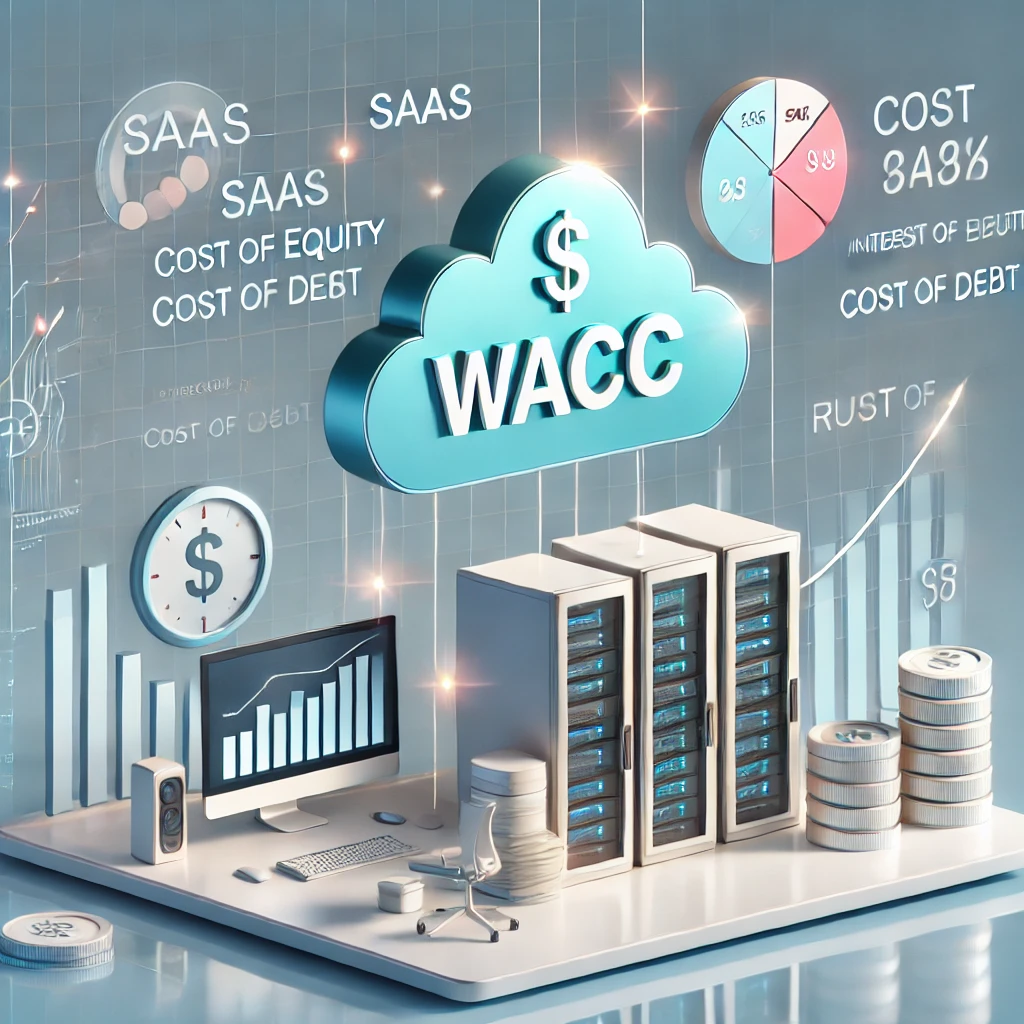
5. The Role of Customer Lifetime Value (CLV) in Reducing SaaS WACC
- Why Include: CLV is a SaaS-specific metric that directly impacts perceived business stability and risk.
- Details: Explain how high CLV/Customer Acquisition Cost (CAC) ratios improve cash flow stability, reducing investor-perceived risk and equity costs. Provide examples of how SaaS companies with high CLV achieve better WACC metrics.
- Subtopics:
- Importance of subscription pricing in maximizing CLV.
- How retention rates reduce long-term equity costs.
6. Future Trends in SaaS WACC
- Why Include: Forward-looking insights establish thought leadership and relevance.
- Details: Predict how emerging technologies (AI, automation, blockchain) and trends like decentralized SaaS applications might influence financing costs. Address how shifting customer behaviors and cloud adoption globally will affect revenue predictability and WACC.
- Potential Trend: Explore how regulatory changes (e.g., global data privacy laws) might introduce new risks impacting WACC.
7. Industry Benchmarks for SaaS WACC
- Why Include: Benchmarks help contextualize WACC for SaaS companies within specific niches.
- Details: Compare WACC across different SaaS sub-sectors, like enterprise SaaS, consumer SaaS, and fintech SaaS. Highlight which sub-sectors typically enjoy lower WACC and why.
- Format: Use tables or charts to present data concisely.
8. SaaS Companies and ESG (Environmental, Social, Governance) Impact on WACC
- Why Include: ESG considerations are increasingly influencing investment decisions.
- Details: Discuss how SaaS companies with strong ESG policies can attract sustainability-focused investors, potentially lowering WACC. Examine how carbon-neutral cloud operations or diverse leadership teams impact perceptions of risk and equity costs.
- Case Study: Highlight a SaaS company known for its ESG initiatives and analyze its cost of capital.
9. How SaaS IPOs Influence WACC
- Why Include: IPOs are significant events that change the cost of capital for SaaS companies.
- Details: Discuss the transition from private to public markets and how this affects equity and debt costs. Analyze how successful IPOs (e.g., Snowflake) set benchmarks for WACC in the industry.
- Subtopics:
- Post-IPO stock performance and its impact on WACC.
- The role of public market investor expectations.
10. Comparison of WACC Across Global SaaS Markets
- Why Include: SaaS companies operate globally, and regional differences matter.
- Details: Explore how SaaS companies in the U.S., Europe, and Asia differ in terms of WACC due to varying interest rates, tax policies, and market maturity. Highlight regulatory and cultural factors impacting risk perception and financing costs.
- Example: Compare WACC in Silicon Valley vs. SaaS hubs like Singapore or Berlin.
Final Thoughts and Course Recommendations
Understanding whether SaaS companies have a lower WACC involves evaluating their unique financial dynamics and comparing them to traditional industries. SaaS companies benefit from predictable revenue models, high gross margins, and low capital expenditures, often leading to a more favorable WACC. However, challenges like high investor expectations and macroeconomic volatility must also be managed carefully.
To gain deeper insights into this topic and develop a strategic approach, consider exploring courses that cover financial analysis, SaaS business models, and corporate finance. Here are a few recommended courses:
Recommended Courses to Enhance Knowledge
- Corporate Finance Essentials (Coursera)
- Covers fundamental principles of WACC, capital structure, and cost of equity.
- Ideal for beginners in financial analysis.
- SaaS Metrics for Financial Performance (Udemy)
- Focuses specifically on SaaS business models, including metrics like CLV, CAC, and gross margins.
- Offers actionable insights for SaaS entrepreneurs and financial analysts.
- Advanced Financial Modeling for SaaS Companies (LinkedIn Learning)
- Provides advanced training on building financial models tailored to SaaS revenue streams and capital structures.
- Recommended for professionals involved in financial planning and investment decision-making.
- Macroeconomic Factors in Corporate Finance (edX)
- Explores the intersection of macroeconomics and corporate financial planning.
- Great for understanding how economic shifts impact WACC and financing options.
- SaaS Finance and Valuation (Reforge)
- A specialized program for SaaS founders and executives, focusing on optimizing financial strategies to attract investment and minimize costs of capital.
By diving into these courses, you can deepen your expertise in financial management and SaaS-specific dynamics, equipping yourself with the tools to make data-driven decisions that positively influence WACC. Whether you are a founder, investor, or analyst, continuous learning in this area can help you stay ahead in the ever-evolving SaaS landscape.
Affiliate Disclosure
This article may contain affiliate links, which means we may earn a commission if you make a purchase or sign up for a service through one of our links. This comes at no additional cost to you and helps support the maintenance and creation of valuable content on this website.
We only recommend products and services that we genuinely believe will bring value to our readers. Our opinions and recommendations are unbiased and based on thorough research and expertise. Thank you for supporting us!



